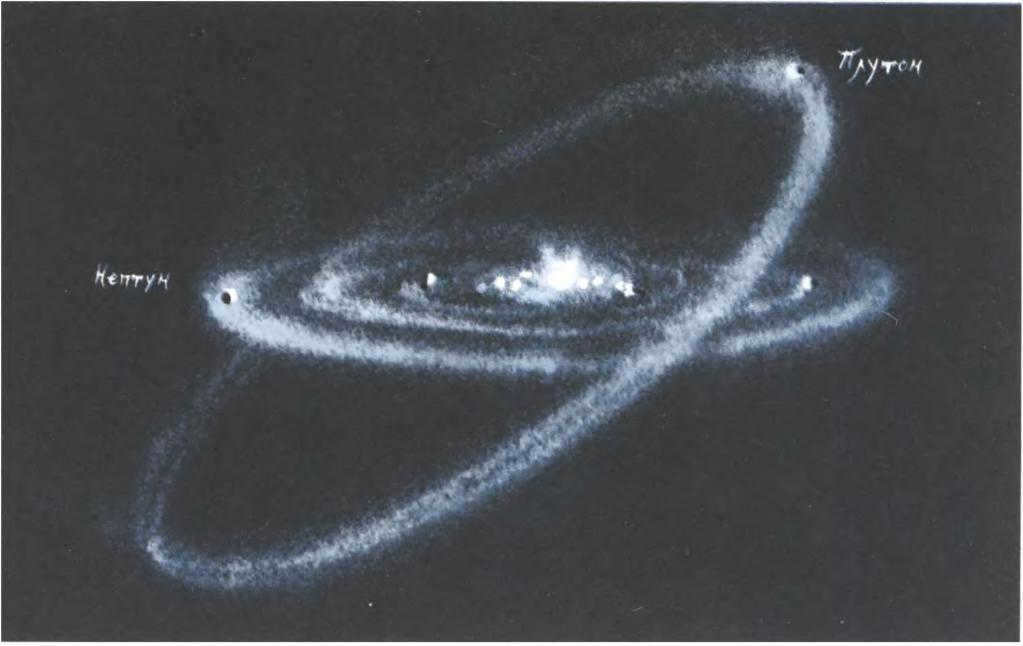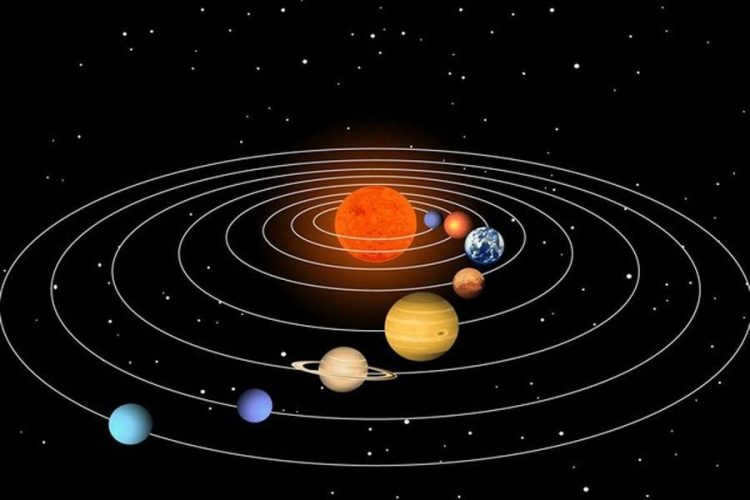
- Planets
There is no longer any doubt that the Sun is orbited by planets. In the not too distant past, in the grand scheme of the Universe’s history, humans believed that the Earth was at the center of our Galaxy. However, today it is unquestionable that the opposite is true.
From Ptolemy to Newton
The notion of how the planets are positioned in the sky was initially presented in the work titled “The Great Mathematical Construction of Astronomy” by the renowned ancient Greek astronomer, Ptolemy. He proposed that their movements occur in a circular path. However, Ptolemy erroneously believed that all the planets, including the Moon and the Sun, revolve around the Earth. For a considerable period, his treatise was widely accepted in both the Arab and Western societies.
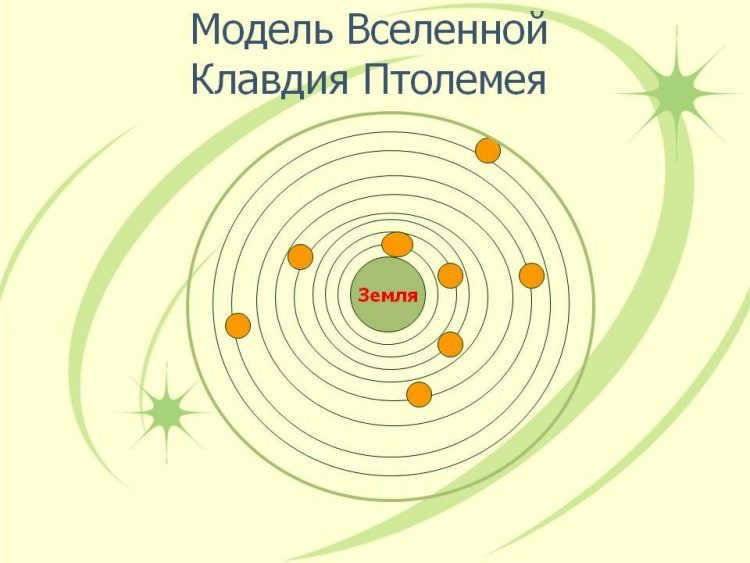
It was Nicolaus Copernicus who brought an end to this controversial fact. by Nicolaus Copernicus. The Polish astronomer introduced his heliocentric system, where he convincingly demonstrated that the Earth is not the center of the universe, and all the planets, based on his strong belief, revolve around the Sun. The Polish scientist’s work “On the Rotation of the Celestial Spheres” was published in Nuremberg, Germany, in 1543. in 1543.
Following the death of Copernicus, a Danish scientist, Tycho Brahe, carried on his work. Brahe, who was incredibly wealthy, outfitted his island with remarkable bronze circles upon which he recorded the findings of his celestial observations. These findings proved instrumental to the mathematician Johannes Kepler, who subsequently formulated his renowned three laws of planetary motion.
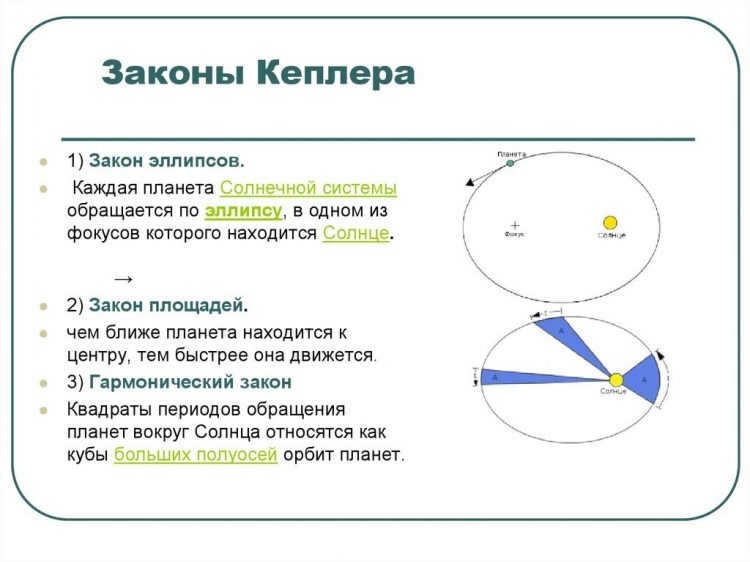
The discovery of the law of universal gravitation and the advancement of humanity’s understanding of the elliptical orbits of celestial bodies were attributed to the renowned English scientist, Isaac Newton. Newton’s convincing explanation that the Moon influences Earth’s tides gained widespread acceptance in the scientific community.
What causes the planets to orbit the Sun?
The planets in our solar system, including the Earth, all follow their own unique paths as they revolve around the Sun. While their speeds and trajectories may vary, they are all held in place by the gravitational pull of our natural celestial body.
The motion of the planets as they orbit the Sun is influenced by two primary forces:
- Towards the center (the gravitational force exerted by the Sun)
- Away from the center (the force of inertia during their translational motion)
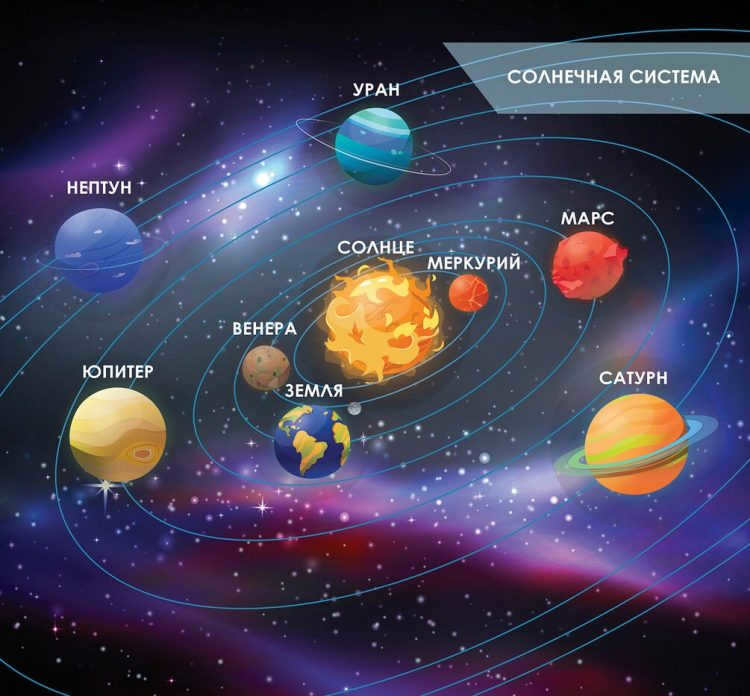
The duration of a full revolution around the Sun varies for each planet. Mercury, being the closest to the star, completes its revolution in 88 days on Earth. Our planet, Earth, takes 365 days and 6 hours to complete its cycle. Jupiter, the largest planet in our solar system, has a revolution period of 11.9 Earth years. On the other hand, Pluto, the planet farthest from the Sun, takes 247.7 years to complete its revolution.
Universal Gravitation Law
The Sun is the most massive celestial body in our galaxy. It outweighs all other objects combined. And in the realm of physics, as we understand it, there exists the force of universal gravity, which remains unchallenged even in the vastness of the cosmos.
The law of universal gravitation stipulates that objects with lesser mass are drawn towards objects with greater mass. This explains why all planets, moons, and other celestial entities are irresistibly pulled towards the Sun, the most massive among them.
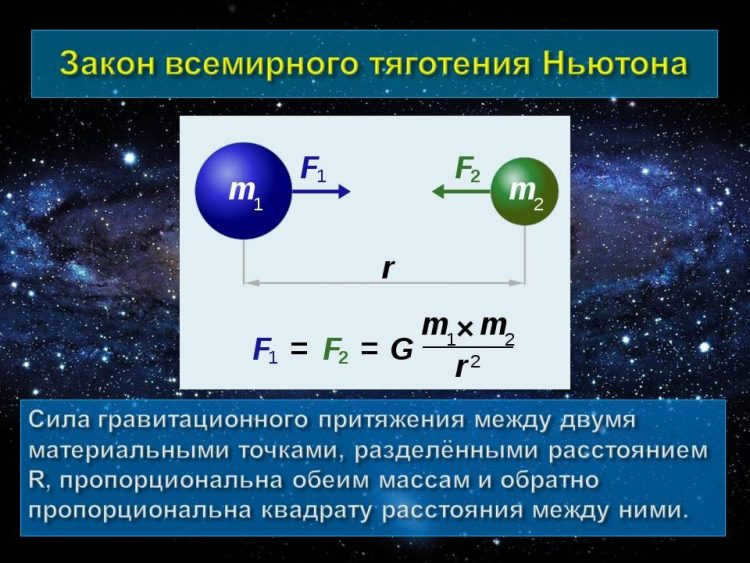
Gravity, in fact, operates in a similar manner on Earth.
Consider what occurs when a tennis ball is thrown into the air. It descends, drawn towards the surface of our planet.
Now that we comprehend the principle of planets being drawn to the sun, the question arises: why don’t they plummet to the surface of the star, but instead orbit it along their own trajectory. Fortunately, there is a very straightforward explanation for this.
Inertia
The theory posits that approximately 4.57 billion years ago, a vast amount of space dust emerged, gradually transforming into a disk and eventually coalescing into the Sun. The outer particles within this dust began to amalgamate, ultimately giving rise to planets. From that point, these planets commenced revolving around the star by virtue of their inertia, perpetually tracing the same path to this day.
It is worth considering that within our solar system, all the planets do not orbit the Sun directly, but rather revolve around a point known as the center of mass. Concurrently, each planet rotates on its axis while exhibiting a slight wobble akin to that of a yule. Moreover, the planet’s axis itself may undergo slight shifts.
Regarding the orbit of each object, its path is determined by its velocity and mass. These characteristics vary for each object, as you are aware. Therefore, it is only natural for the Earth and other planets to revolve around the Sun, and not in any other manner.
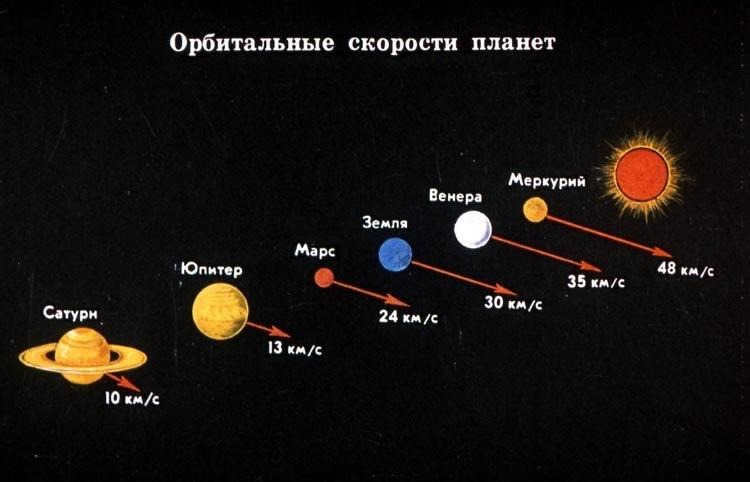
Hence, the planet’s inertial motion causes it to distance itself from the Sun, while the force towards the center of the orbit is what curves its trajectory and maintains it in orbit. All planets revolve around the Sun in the same direction and also rotate on their own axes (except for Venus and Uranus).
During their formation, virtually every planet experienced numerous impacts from asteroids, which altered their shape and orbit radius. The close formation of a group of planets and the accumulation of space debris also play a significant role, resulting in a reduced distance between them and causing disruptions in the gravitational field.
The revolution of planet Earth around the Sun and its importance
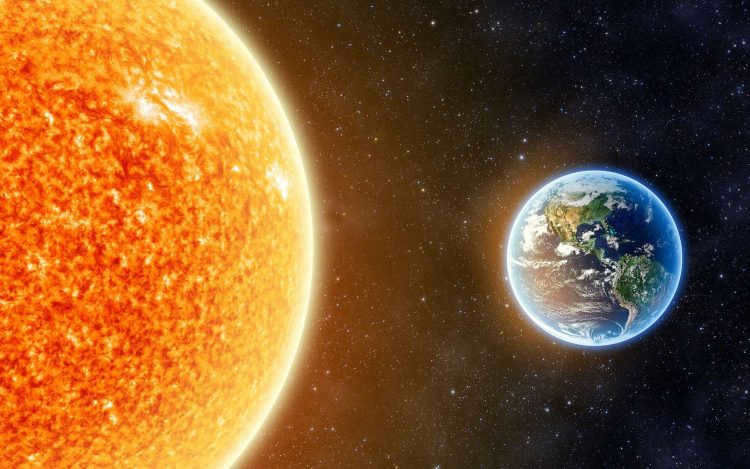
The Earth is estimated by scientists to have formed over 4.5 billion years ago. Throughout this extensive period, the planet has maintained a relatively stable orbit around the Sun, with its distance from the Sun remaining relatively constant. While the Earth’s orbit is not perfectly circular, it has been able to maintain its stability due to a balance between the planet’s speed and the gravitational pull of the Sun.
If the Sun’s gravitational force were to increase significantly or if the Earth’s speed were to noticeably decrease, the planet would be pulled into the Sun. On the other hand, if the Earth’s speed were to increase significantly, it would eventually escape the gravitational pull of the Sun and drift off into space, no longer remaining a part of the solar system.
The distance between the Sun and the Earth plays a crucial role in maintaining the optimal temperature on the Earth’s surface.
An orbit is the trajectory that a planet follows around a star. This flight’s trajectory is not perfectly circular, but rather elliptical, with a maximum difference of 5 million kilometers.
The point of the orbit closest to the Sun, known as perihelion, is 147 km away. The Earth reaches this point in January. In July, the planet is at its farthest distance from the Sun, which is 152 million kilometers. This point is called aphelion.
The rotation of the Earth on its axis and its orbit around the Sun cause changes in daily and yearly cycles, respectively.
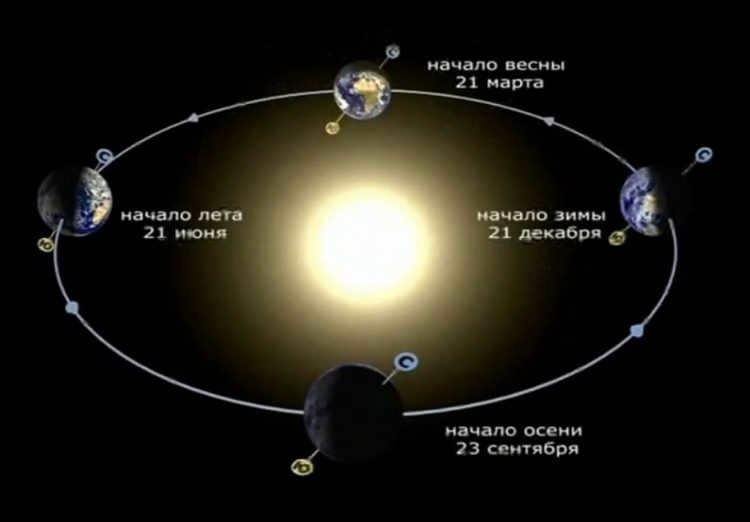
The orbit of the Earth around the Sun
While it may not be noticeable to us, the Earth is in constant motion as it revolves around the center of our solar system. This movement is largely imperceptible due to the Earth’s immense mass. However, in reality, we are actually traveling through space at a rate of approximately 30 kilometers per second. It may seem unbelievable, but that is the calculated speed. On average, the Earth is estimated to be approximately 150 million kilometers away from the Sun. In order to complete one full revolution around the Sun, it takes the Earth approximately 365 days.
The precise distance that our planet covers in a year as it orbits around the sun is 942 million kilometers. We are journeying alongside it in space, following an elliptical path at a velocity of 107,000 kilometers per hour. The rotation occurs in a counterclockwise direction, from west to east.
Therefore, our planet is in a perpetual state of movement. It moves through space alongside the Sun, as they both revolve around the center of the Galaxy. This, in turn, continues to traverse through the vast Universe. However, the most significant motion for all living organisms is the Earth’s rotation around the Sun and its own axis. Without this movement, the conditions on our planet would not be conducive to sustaining life.
Clip
It is a widely accepted fact that the Sun is at the center of our solar system, and that the Earth and other planets orbit around it. However, modern scientists now argue that everything in the solar system, including the Sun, actually revolves around a point known as the “center of mass”. This concept may seem confusing at first, but it sheds new light on the dynamics of our celestial neighborhood.
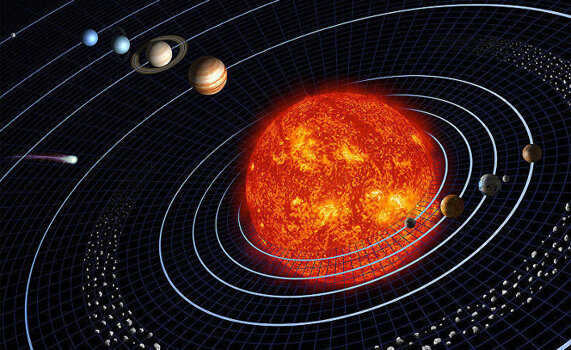

As we all know, the Sun is considered to be the center of the solar system, and it is believed that eight planets, dwarf planets, asteroids, meteorites, and comets revolve around it. This is a fact that has been taught to us since our school days. It can be said that this is an undeniable truth, as scientists have proven that the Earth is not the center of the universe, and that it, like the other planets, orbits the Sun.
However, there is some nuance to this truth. In reality, everything in the solar system, including the Sun itself, revolves around a point known as the “center of mass of the solar system.” Scientists have recently made this revelation through a series of videos. What secrets did they uncover?
Rotation around the barycenter
The barycenter, also known as the center of mass, is the focal point around which the various celestial bodies in our solar system revolve. It is the point where an object achieves perfect balance, with its mass evenly distributed in all directions. Interestingly, the center of mass can sometimes be found right in the middle of an object.
A ruler provides a good example of this concept. If you try placing a ruler on your finger and adjust it until it remains stably balanced without falling off, you will discover a specific point on the ruler where you can hold it using just one finger. This point is known as the center of mass or, alternatively, the center of gravity.
Within our solar system, it is uncommon for the center of mass to align perfectly with the center of the Sun. This indicates that not all celestial bodies within the solar system orbit directly around the Sun’s center. While it is true that planets do orbit around the Sun, we are specifically discussing the precise position and true center around which all objects within the solar system revolve.
In order to demonstrate this concept, planetologist James O’Donoghue, employed by the Japanese space agency JAXA, has produced an animated visualization. This animation depicts the Sun, Saturn, and Jupiter engaging in a tug-of-war around the barycenter, which results in the Sun initiating motion on a series of small, looping orbits.
The planetologist spends his free time creating animations that illustrate the workings of planets, stars, and the speed of light from a physics standpoint. He points out that while it may seem logical to assume that we orbit around the Sun’s center, this is actually quite rare. The center of mass of the Solar System rarely aligns with the center of the Sun, causing the Sun itself to travel millions of kilometers around the barycenter. At times, it passes over the barycenter, while at other times it deviates from it.
The position of the center of mass in the Solar System is not identical to the center of the Sun
The query is as follows: why is there a discrepancy between the center of mass in the Solar System and the center of the Sun, despite the fact that the Sun contains the overwhelming majority of the system’s mass? Logically, the center of the Sun should coincide with the barycenter of the solar system, since it accounts for 99.8% of the system’s mass.
In reality, this can be attributed to Jupiter and its gravitational influence. As mentioned earlier, the Sun constitutes 99.8% of the solar system’s mass, while Jupiter accounts for most of the remaining 0.2%. This mass exerts a gravitational pull that slightly shifts the Sun away from the barycenter of the solar system, which ideally should align with the center of the Sun.
It can be said that Jupiter slightly influences the rotation of the Sun. Put differently, the idea that planets orbit around stars is not an unchanging truth since both planets and stars revolve around their own center of mass.
What is the barycenter?
In the field of astronomy, the barycenter, also known as the center of mass, refers to the point around which two or more celestial bodies revolve. This concept holds significance in disciplines like astronomy and astrophysics.
If one of the orbiting bodies is significantly larger than the other and they are in close proximity to each other, the barycenter will typically be located within the larger object.
In this scenario, instead of two entities circling around a point in between them, the less massive object will revolve around the more massive one. Simultaneously, it is evident that the heavier body will exhibit a slight wobble. The same principle applies to the Earth-Moon system, as the center of mass is situated 4691 km away from the Earth’s center, which is only 75% of the Earth’s radius (6378 km).
The Earth and Moon engage in a simpler choreography, with the barycenter remaining within the Earth. Speaking of which, it does not coincide with the Earth’s actual center due to the Moon’s gravitational force, which slightly pulls the Earth towards it.
When two objects possess identical masses, it is customary for the barycenter to reside between them and for both objects to orbit around it. This is evident in the scenario of Pluto and its companion Chiron, along with numerous binary asteroids and stars. Within our solar system, a similar phenomenon can be observed among multiple planets and their satellites.
Speaking of which, Pluto engages in a unique choreography with its companion Chiron, but there exists one distinction, namely that the barycenter is consistently positioned external to Pluto.
In situations where a less massive entity is situated at a considerable distance, the barycenter may fall outside the larger entity. Such is the case with Jupiter and the Sun. Despite the Sun’s magnitude exceeding Jupiter’s by a thousandfold, the barycenter is situated exterior to the Sun due to the sizable gap separating the two.
In the end, each planetary system revolves around an intangible point positioned at the core.
The significance of the barycenter for scientists
The barycenter plays a crucial role in aiding astronomers in the detection of concealed planets in orbit around distant stars, as pinpointing exoplanets directly is an incredibly challenging task. Oftentimes, these planets are obscured by the intense luminosity emanating from stars revolving around the center of mass.
Moreover, through analyzing the stellar wobble and investigating barycenters alongside various other techniques, scientists have successfully identified numerous exoplanets orbiting distant stars.
In the field of astronomy, there exists a concept known as “barycentric coordinates,” which refers to the coordinates of a specific point in relation to a coordinate system centered around the system’s center of gravity. The International Celestial Reference System (ICRS) utilizes a barycentric coordinate system that centers around the heart of the solar system in order to ascertain the precise positions of celestial objects.
Sasapost (Egypt)
Here is a brief account of its history. In ancient times, people noticed the planets moving in the sky and speculated that they, along with the Earth, revolved around the Sun. Centuries later, when this knowledge had been forgotten, Copernicus rediscovered this truth. This led to a new inquiry: what is the exact nature of the planets’ orbit around the Sun? Do they follow a circular path with the Sun at the center, or do they trace a different curve? How fast do they move? These were some of the questions that arose.
It took a short amount of time to discover the truth. Following Copernicus, there was once again a period of uncertainty and a heated debate regarding whether the planets, including Earth, revolved around the Sun or if Earth was actually at the center of the universe. In the midst of this debate, a man by the name of Tycho Brahe (Tycho Brahe (1546-1601) was a Danish astronomer) devised a method to provide an answer to this question. He determined that it was crucial to meticulously observe the positions of the planets in the sky, accurately record these observations, and then choose between the two conflicting theories. This marked the beginning of modern science, as it emphasized the importance of observing the object in question, documenting all relevant details, and hoping that the acquired information would serve as a foundation for one theory or another. Thus, Tycho Brahe, a wealthy individual who owned an island near Copenhagen, equipped his island with large bronze circles and specialized observation points, diligently recording the positions of the planets night after night. It is only through such rigorous work that any significant discovery is made.
After the collection of all this data, it ended up in the possession of Kepler. (Johannes Kepler (1571-1630) was a German astronomer and mathematician who served as Brahe’s assistant) He was attempting to determine how the planets moved around the sun. Kepler was searching for a solution through trial and error. One day, it appeared to him that he had already found the answer: he concluded that the planets moved in a circular pattern, but the Sun was not located at the center. However, Kepler soon noticed that one of the planets, possibly Mars, deviated from its expected position by 8 angular minutes. This made him realize that his previous conclusion was incorrect, as Tycho Brahe could not have made such a significant mistake. Based on the precision of the observations, Kepler decided to revise his theory and ultimately discovered three important facts.
The principles governing the movement of planets around the Sun
Initially, Kepler ascertained that the planets orbit the Sun in elliptical paths, with the Sun occupying one of the focal points. An ellipse, a shape familiar to artists, resembles a stretched circle. This concept is also familiar to children, who are often taught that by threading a string through a ring, securing the ends, and inserting a pencil into the ring, they can trace the path of an ellipse.
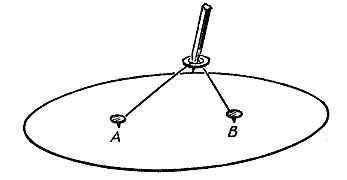
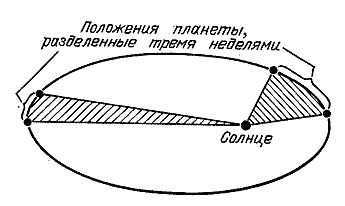
After some time, Kepler developed a third principle that did not focus on the movement of one planet around the Sun, but rather connected the movements of multiple planets. According to this principle, the time it takes for a planet to complete one revolution around the Sun depends on the size of its orbit and is directly proportional to the square root of the cube of this value. Additionally, the size of the orbit can be determined by measuring the diameter of the widest point of the ellipse.
Kepler’s exploration led to the discovery of three laws, which can be condensed into a single law by stating that a planet’s orbit is an ellipse. According to this law, the radius-vector of the planet describes equal areas for equal time intervals, and the time it takes for a planet to complete its orbit around the Sun is proportional to the size of the orbit raised to the power of three. In other words, it is proportional to the square root of the cube of the size of the orbit. These three laws, collectively known as Kepler’s laws, provide a comprehensive description of planetary motion around the Sun.
At the same time, Galileo made a groundbreaking observation about the law of inertia. Later, Newton came along and concluded that a planet in orbit around the Sun doesn’t require an external force to continue moving; if there were no force, the planet would simply move in a straight line. However, in reality, the planet doesn’t move in a straight line. Instead, it consistently ends up closer to the Sun than it would if it were moving freely. This means that its motion, its velocity, is deflected towards the Sun.

The origin of this force (gravitational force) was evidently located in close proximity to the Sun.
Observing Jupiter and its orbiting satellites through a telescope, people noticed that it resembled a miniature solar system. The satellites seemed to be drawn towards Jupiter, much like the Moon revolves around the Earth and is attracted to it. This led to the natural conclusion that gravity is at work universally. It was then logical to generalize these observations and propose that all bodies attract one another. Thus, the Earth must attract the Moon in the same way that the Sun attracts the planets. It is worth noting that the Earth’s gravitational pull also affects everyday objects, such as when you sit on a chair and feel grounded despite the desire to soar through the air. This phenomenon of objects being attracted to the Earth was widely recognized. Newton’s hypothesis was that the Moon remains in its orbit due to the same gravitational forces that attract objects to the Earth.
What causes tides to occur
Firstly, let’s talk about tides. Tides occur due to the gravitational pull of the Moon on the Earth and its oceans. This concept was previously understood, but here’s the intriguing part: if the Moon’s gravitational force only attracted the waters and caused them to rise on the side of the Earth closest to it, we would expect to see just one tide per day, directly under the Moon. However, as we all know, tides occur twice a day, approximately every 12 hours. Another theory suggested that the Moon attracts the Earth, but the water doesn’t keep up with it. It was Sir Isaac Newton who first comprehended the truth behind tides: the Moon’s gravity affects both the Earth and the water equally when they are at the same distance. However, the water at point y is closer to the Moon compared to the Earth, while at point x it is farther away. As a result, the water at point y is more strongly attracted to the Moon than the Earth, while at point x, it is less so. This combination of factors results in the phenomenon of two tides occurring.
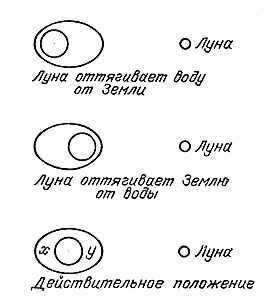
In reality, the Earth is engaged in the same activity as the Moon – it is engaged in circular motion. The equilibrium of forces is maintained by the Moon’s influence on the Earth, but what exactly is this equilibrium? Similar to how the Moon orbits in a circle to counterbalance the gravitational pull of the Earth, the Earth also follows a circular path. Both celestial bodies revolve around a shared center, and the forces acting on the Earth are harmonized in such a way that the water at x experiences a weaker attraction from the Moon compared to the water at y, resulting in a bulge in both regions. This is the explanation for the occurrence of tides, which happen twice a day.
The remarkable discovery of the speed of light
As scientific knowledge advanced, measurements became increasingly precise and provided more convincing evidence for Newton’s laws. The initial accurate measurements were conducted on Jupiter’s satellites. It seemed that careful observation of their orbits would confirm Newton’s laws. However, it was soon discovered that this was not the case. Jupiter’s satellites were observed to appear at calculated positions 8 minutes earlier and 8 minutes later than predicted by Newton’s laws. This peculiar phenomenon occurred when Jupiter approached or moved away from Earth.
Rømer (Olaf Rømer (1644-1710) – Danish astronomer)came to the intriguing realization that light does not travel instantaneously. He reached this conclusion by recognizing the validity of the law of gravitation and deducing that it takes a certain amount of time for light to travel from Jupiter’s satellites to Earth. When we observe Jupiter’s satellites, we are not seeing them in their current position, but rather in a position that existed several minutes ago. The number of minutes corresponds to the time it takes for light to reach us. As Jupiter moves closer to us, the light reaches us faster, and when Jupiter is farther away, the light takes longer to reach us. As a result, Römer had to make adjustments to his observations to account for this time difference. This allowed him to determine the speed of light, marking the first establishment of this fundamental property of light.
The planet’s discovery
There was an additional issue that arose: the planets were not moving in perfect ellipses due to the influence of Newton’s laws. These laws stated that the planets not only experienced attraction from the Sun, but also exerted a weak attraction on each other, causing a slight alteration in their movement. The larger planets, such as Jupiter, Saturn, and Uranus, were already known, and scientists had calculated how much they should deviate from their ideal Keplerian elliptical orbits due to their mutual attraction. Once these calculations were completed and confirmed by observations, it was discovered that Jupiter and Saturn were moving exactly as predicted, but something peculiar was happening with Uranus. This could have been a reason to doubt Newton’s laws, but it was important not to lose hope. Two individuals, John Couch Adame (1819-1892), an English mathematician and astronomer, and Urbain Leverrier (1811-1877), a French astronomer, independently made these calculations and simultaneously suggested that the motion of Uranus was being influenced by an unseen planet. They sent letters to various observatories stating, “Direct your telescopes to this location, and you will spot an unknown planet.” One of the observatories brushed off this suggestion, thinking it was just a young boy playing with paper and pencil, pretending to know the whereabouts of a new planet. However, another observatory took the suggestion more seriously, and it was there that Neptune was discovered!

The paths that planets in the solar system trace around the Sun are known as their orbits. These orbits can vary in terms of their length and shape, which in turn impact the climate and surface temperature of these celestial bodies. Therefore, it is important to understand the shape of the planetary orbits and their effects on the celestial bodies themselves.
Perihelion, aphelion, and eccentricity
Let’s gain an understanding of the fundamental characteristics of the orbital path. All planets within the solar system orbit around the Sun. As they traverse their trajectories, these celestial bodies have points of maximum and minimum distance from the central star. These points are known as aphelion and perihelion, respectively. The climatic conditions experienced on each planet are directly influenced by the values of these points.
The perihelion and aphelion values for the planets in our system are as follows:
- Mercury: 46 – 69.82 million kilometers;
- Venus: 107.5 – 109 million km;
- Earth: 147.1 – 152.1 million km;
- Mars: 206.7 – 249.2 million km;
- Jupiter: 740.7 – 816 million km;
- Saturn: 1.35 – 1.5 billion km;
- Uranus: 2.73 – 3.01 billion km;
- Neptune: 4.45 – 4.5 billion km.
Based on the provided data, it can be observed that some planets have a minimal difference between their minimum and maximum distances from the Sun, while others have a significant difference. This observation is closely tied to another term that is necessary for describing the planets’ orbits – eccentricity.
Eccentricity determines the shape of the trajectory along which a planet moves. To calculate this parameter, knowledge of the planet’s major and minor semi-axes of its orbit is required. Each shape of the orbital path corresponds to a different numerical value of eccentricity:
- 0 – circle;
- 0 to 1 – ellipse;
- 1 – parabola;
- 1 to ∞ – hyperbola;
- ∞ – straight line.
All the planets in the Solar System have elliptical orbits with eccentricity values greater than zero. Venus and Neptune have the most circular orbits, while Mercury and Mars have the most elongated orbits.
Length of Planetary Year
The time it takes for a celestial body to complete one revolution along its orbit is known as its sidereal rotation period or “planetary year.” The length of a planetary year is determined by the average radius of the orbit and the speed at which the planet orbits.
To simplify the description, planetary years are measured in terms of Earth days and years. For instance, on Mercury, a single year lasts for 0.24 Earth years or 89 Earth days, making it the shortest planetary year in our solar system. On the other hand, the planet Neptune has the longest year, spanning approximately 164 Earth years.
The factor responsible for the occurrence of seasons
The occurrence of seasons on the planets in our solar system is primarily determined by the angle of inclination of their axis of rotation in relation to their orbit. A smaller angle of inclination results in more stable weather patterns and the absence of distinct seasons. On the other hand, celestial bodies with an inclination angle exceeding 90 degrees also do not experience seasonality.
Seasonal changes are typically observed on objects with an axis inclination ranging from 20 to 30 degrees:
Despite its minimal axis tilt, Mercury still experiences “summer” and “winter” due to the high eccentricity of its orbit. The temperature difference between the perihelion and aphelion points on Mercury reaches an astonishing 620 degrees Celsius.
Hence, the dimensions and configuration of the orbit that traces the celestial body’s trajectory around the Sun significantly impact the generation of temperature conditions on said body. Specifically, the Earth’s motion characterized by its slight eccentricity and relatively close distance to the Sun, combined with its optimal axial tilt, renders its temperature exceptionally conducive to the sustenance of living organisms.
The Solar System: Definition, Composition, Planetary Order, Structure, Photos and Videos
The Sun possesses an immense gravitational pull that keeps the planets in close proximity, resulting in the formation of a complete system. The planets orbit around the Sun and exhibit distinct characteristics based on their respective positions. Ongoing scientific research on the solar system continues to yield remarkable findings that enhance our comprehension of the cosmos.
What is the Solar System?
The Solar System is a system consisting of a central star and a collection of planets that orbit around it. Scientists have determined that the Solar System is approximately 4.57 billion years old and formed as a result of the gravitational compression of a gas-dust cloud.
At the center of the Solar System is a luminous star known as the Sun, which exerts gravitational force on the planets and other celestial objects, causing them to orbit at specific distances. The Sun is significantly larger in diameter compared to the other objects within its gravitational influence.
In addition to the Sun, the Solar System is comprised of eight major planets and five dwarf planets. It is situated within the Milky Way galaxy, specifically within the Orion arm.
Origins
Given the immense age of the solar system, there is only speculation about its origins. One widely accepted theory is the nebular theory, which was proposed by scientists Laplace, Kant, and Swedenborg in the 18th century. This theory suggests that the system formed through the gravitational collapse of a portion of a massive cloud composed of gas and dust. Over time, this hypothesis has been further supported by data gathered from space exploration ventures.

The formation of the Solar System and the Earth can be divided into several stages:
Currently, scientists believe that the formation of the solar system occurred in the following way:
- In the beginning, there was a cloud in this area of the universe. This cloud consisted of helium, hydrogen, and other materials that were produced by the explosions of old stars. A small portion of this cloud began to condense and act as the center of gravitational collapse. Over time, it started to attract the surrounding matter.
- As the substances were attracted, the size of the cloud started to decrease, and its rotation speed increased. Eventually, it took on a disk-like shape.
- As the cloud continued to compress, the density of particles per unit volume increased. This led to the gradual heating of the substance due to frequent molecular collisions.
- As the center of gravitational collapse reached temperatures reaching several thousand kelvins, it emitted light, signifying the creation of a protostar. Simultaneously, other areas of the disk began to compress, eventually becoming gravitational centers for planet formation.
- The final phase of solar system formation occurred when the temperature at the core of the protostar surpassed several million kelvins. This sparked a fusion reaction between helium and hydrogen, resulting in the birth of a fully-fledged star. The remaining disk material gradually coalesced into planets, which then orbited the Sun in the same direction and on the same plane.
This process spanned an immense period of time, and scientists can only conjecture how many years were required for the solar system to take shape.
The organization of the solar system
The central component of the system is the Sun, composed primarily of hydrogen and helium. It possesses a scorching surface temperature of approximately 6000 degrees Celsius and dwarfs all other entities within its gravitational pull. This celestial body is classified as a yellow dwarf star.
Encircling this radiant entity, at varying distances, are a collection of celestial bodies known as planets. These planets are further categorized by researchers into two distinct groups: terrestrial and gas giants.
Planets in the Earth Group
The Earth Group is positioned in closer proximity to the Sun. The planets within this group possess a solid composition and a high density, resulting in their sizes being smaller in comparison to the gas giants.
Mercury
The planet nearest to the Sun is also the smallest within the solar system. It has a radius of merely 2440 km. Its name derives from Mercury, the god of commerce. The surface of Mercury is gray in color, leading to numerous comparisons with the Moon. This planet lacks any satellites and due to the intense solar winds, its atmosphere is nearly completely sparse.
Venus
Venus, the second planet from the Sun, is named after the ancient Roman goddess of love. It has two distinctive features: the lack of natural satellites and a high concentration of carbon dioxide in its atmosphere. Venus has a radius of 6051 km, which is only 5% smaller than Earth’s radius, making them often referred to as “sister planets”. However, despite their similar sizes, Venus has a unique appearance, resembling a milky-colored sphere. Its surface is composed mainly of solidified lava, with occasional craters from meteorite impacts.
Planet Earth
Planet Earth is the third celestial body from the Sun and is unique in that it is the only planet in our solar system with vast bodies of water. It is home to a diverse range of ecosystems and is the only known planet to support life. With a radius of 6378 kilometers, it is a fascinating and dynamic planet.
The planet Mars, often referred to as the “Red” planet due to its distinctive color, is located at the farthest distance from the Sun compared to the other planets in the Earth group. In terms of size, Mars is considered the second smallest planet after Mercury, with a radius of 3396 kilometers. The surface of Mars is mainly composed of sandy and earthen landforms, which are divided into light and dark areas known as continents and seas, respectively.
In the 21st century, Mars has become a subject of great interest to scientists. Due to its relative proximity to Earth, various Mars rovers have been regularly sent to the planet to gather valuable data and insights.
The gas group planets
There are four gas giants in this category, which are situated at a greater distance from the Sun compared to the rest of the planets. Their immense size can be attributed to their low density and significant presence of gaseous substances in their composition.
Jupiter
Jupiter, the largest celestial body in our solar system, boasts an astounding radius of 69,912 kilometers, making it nearly 20 times bigger than Earth. While scientists have yet to definitively determine its exact composition, they have observed that the planet contains higher concentrations of xenon, argon, and krypton compared to the Sun. Jupiter also boasts an impressive collection of 67 satellites, some of which are comparable in size to actual planets. For instance, Ganymede surpasses Mercury by a whopping 8% in size, while Io even possesses its own atmosphere. An intriguing theory suggests that Jupiter was initially destined to become a fully-fledged star, but ultimately remained a planet during its developmental phase.
Saturn
Saturn, the sixth planet in our solar system, is well-known for its stunning rings composed of ice and stony meteoroids. With a radius of 57,360 kilometers, Saturn’s surface composition remains a subject of ongoing scientific research. However, experts have found that it shares a strikingly similar chemical makeup to that of the Sun. Additionally, Saturn boasts an impressive collection of 62 satellites orbiting around it.
Uranus, the third largest planet in the solar system, has a radius measuring 25267 kilometers. What sets Uranus apart is its incredibly low temperature, reaching as low as -230 degrees Celsius, making it the coldest planet. Another unique characteristic of Uranus is its tilted axis of rotation, giving it the appearance of a rolling ball as it moves through space. The planet’s surface is predominantly composed of ice, with traces of helium and hydrogen present as well.
Neptune
The discovery of Neptune, the eighth planet from the Sun, did not come from direct observation but rather from mathematical calculations. Scientists noticed irregularities in the movement of Uranus and hypothesized that these irregularities were caused by the gravitational pull of another large celestial body. Neptune has a radius of 24,547 kilometers and its surface is similar to that of Uranus. However, it is known for having the most powerful winds in the entire solar system, reaching speeds of up to 260 m/s.
Order of Planetary Orbits
Each celestial body in our solar system has its own unique orbit around the Sun. This orbital path determines the length of a year, which is the time it takes for a planet to complete one full revolution around the Sun. These orbital periods are often measured in Earth days.
- Mercury, being the closest planet to the Sun, has the shortest orbit and completes a full revolution in just 88 Earth days.
- Venus, the second planet from the Sun, takes 224 Earth days to complete one orbit.
- Earth, our home planet, has a year that lasts 365 days.
- Mars, the fourth planet from the Sun, has a longer year than Earth, taking 687 Earth days to complete one revolution.
- Jupiter, the largest planet in our solar system, has an orbital period of 4332 Earth days.
- Saturn, known for its majestic rings, takes a whopping 10759 Earth days to complete one orbit, which is equivalent to nearly 30 Earth years.
- Uranus, the seventh planet from the Sun and one of the farthest, has the longest orbital period of all. It completes one full revolution in 30685 Earth days.
- Neptune has the largest orbit and has to cover the longest distance during its year, which spans 60190 days – nearly 165 years.
Additionally, each planet rotates at its own speed, resulting in varying lengths of day.
Is Pluto considered part of the solar system?
Since the 19th century, scientists have hypothesized the existence of a ninth planet in the solar system, located at the farthest distance from the Sun. In 1930, Clyde Tombaugh, a 23-year-old employee of the Mount Wilson Observatory, successfully discovered Pluto. He accomplished this by regularly photographing the night sky and searching for celestial objects in motion. The discovery was made in the region known as the Kuiper belt.
In the same year, Pluto was officially designated as the ninth planet. Because of a scarcity of information, it was measured in comparison to Earth in terms of size. However, subsequent studies revealed that it has a radius of merely 2376 kilometers and its mass is 6 times smaller than that of the Moon.
The majority of the planet’s surface is composed of rock and ice, similar to other bodies in the Kuiper Belt. Pluto has five satellites orbiting around it. Its orbit around the Sun is elliptical, and at its closest approach, it is closer to the Sun than Neptune, while at its farthest distance, it is 7.4 billion kilometers away.
While studying the Kuiper Belt further, scientists have discovered several other small planets that are similar in size to Pluto. In 2006, it was decided to classify them as dwarf planets. Since then, Pluto is no longer considered the ninth planet of the solar system. However, some scientists argue that it should be reclassified as a major planet.
Additional entities
Besides the Sun and planets, there are other entities within the system. These entities encompass:
- Minor planets, which are smaller in size compared to the major planets;
- Kuiper belt – a disk-shaped zone containing numerous icy bodies, situated beyond the orbit of Neptune;
- The Oort cloud, a collection of icy conglomerates;
- Comets – formations of gas, dust, and ice traversing through space;
- Asteroids – rock formations moving between Mars and Jupiter;
- Meteorites – small solid objects that descend onto Earth, transforming into meteors upon entering the atmosphere and disintegrating before reaching the surface of the planet.
Occasionally, asteroids and comets from neighboring galaxies may enter the Solar System, although this occurrence is quite infrequent.
The Oort Cloud beyond the Solar System
Stretching beyond the Solar System and the Kuiper Belt, the Oort Cloud occupies a vast expanse. Its inner limits commence at a distance of 2000 to 5000 a.u. from the Sun, while its outer boundaries extend from 100000 to 200000 a.u. To facilitate analysis, researchers classify this region into outer and inner sections.
The cloud is composed of countless entities composed of ethane, water, methane, ammonia, hydrogen, and various other compounds. Additionally, rocky asteroids are present, accounting for 2% of the overall population. The majority of these bodies have a diameter of less than one kilometer, with only a few dwarf planets being exceptions to this rule.
Outer Space Between Planets
It is a common misconception that there is empty void between planets. However, this belief is incorrect. The Sun constantly releases charged particles that traverse through space at a staggering speed of 1.5 million kilometers per hour, creating what is known as the heliosphere. This stream is referred to as the solar wind. In the absence of a magnetic field to retain its atmosphere, any celestial body will be stripped away by these charged particles. This is precisely what has happened to Mars and Venus.
Space Colonization
In the 20th century, individuals began actively exploring space, not only observing it through telescopes but also by launching various satellites, shuttles, rockets, and more. Scientists are also searching for planets that could potentially support life. Unfortunately, Earth is susceptible to cataclysms that could occur at any moment, which is why humanity must seek out a new home. Therefore, the prospect of space colonization is not just a distant dream for modern observatories.
As far back as the previous century, probes were sent to various planets, transmitting valuable information about their journeys. This data helps us gain a better understanding of the structure and characteristics of objects within our solar system.
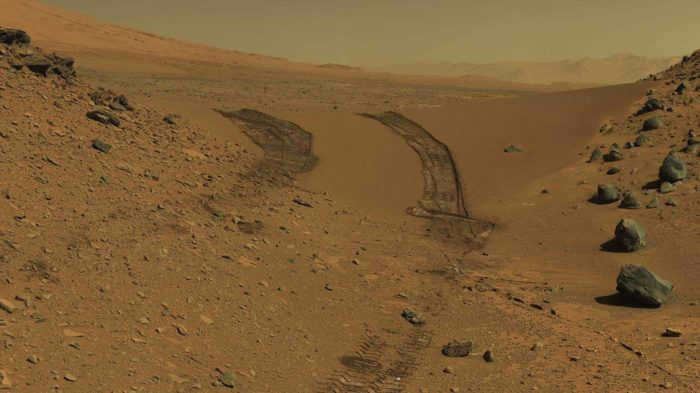
Traces left by the rover on the Martian surface
When it comes to direct colonization, it has become commonplace in the 21st century to send lunar rovers and Mars rovers to explore the moon and the fourth planet in search of signs of life and other extraordinary discoveries. Currently, however, humanity is still in the early stages of space exploration, so talk of potential relocation to another planet is premature. Furthermore, most of the large celestial bodies in our solar system are inhospitable to life.
Reasons for the enduring stability of the solar system
One of the remarkable aspects of the solar system is the consistent and unwavering stability that has endured for billions of years. This can be attributed to several key factors. Firstly, all the planets within the solar system follow their own distinct orbits around the Sun, maintaining a safe distance from one another and avoiding any collisions. Each planet is subject to the gravitational pull exerted by the Sun, a force that obeys the law of universal gravitation. This constant gravitational influence ensures that the planets remain in their designated paths and do not deviate from their orbits.
Another crucial factor contributing to the stability of the solar system is the absence of friction in the vacuum of space. Without the presence of a frictional force, the planets are able to move at a constant velocity, free from any external resistance. This perpetual motion allows for an unchanging and predictable planetary system, as the planets continue to orbit the Sun without any disturbances.
Overall, the combination of individual orbital paths, the gravitational pull of the Sun, and the absence of friction in space has resulted in the remarkable and enviable stability of the solar system for billions of years.
The Earth’s Position
The Earth holds a unique position in the solar system, being the birthplace of life. It orbits the star in an elliptical path, making it the third planet from the Sun. At its furthest point, known as aphelion, the Earth is 152 million kilometers away from the Sun. Conversely, at its closest point, known as perigee, it is only 147 million kilometers away.
Thanks to its favorable position, the Earth receives a constant supply of heat from the Sun’s rays. The surface temperature varies from -89 to 57 degrees Celsius, depending on the time of year and location. These conditions provide an ideal environment for the emergence and evolution of life.
The position of the solar system within the galaxy
In medieval times, there was a belief that the Earth occupied the central position in the universe. This assumption seemed reasonable since the vastness of the cosmos was not fully understood at that time. However, subsequent discoveries revealed that our planet is merely a component of a larger entity known as the solar system, with a massive star at its core. Further exploration led to the realization that the solar system is just one part of an immense galaxy called the Milky Way, which itself is one of many galaxies in the universe.
Scientists have created a comprehensive model of the Milky Way, encompassing all known boundaries and stretching approximately 100,000 light years in length. To aid in visualization, the galaxy is often depicted as a flattened disk. The solar system, somewhat askew, is situated approximately 28,000 light years away from the galactic center.
Exploring the solar system
Since the mid-20th century, extensive efforts have been made to investigate the various planets within our solar system. In 1957, the Soviet Union successfully launched Sputnik-1 into Earth’s orbit, where it remained for several months, gathering valuable data about our planet.
Throughout the following two decades, up until the 1980s, humans continued to send Voyager spacecrafts to explore the majority of the planets within our solar system, capturing numerous close-up images. These images proved instrumental in creating comprehensive descriptions of these celestial bodies and analyzing their composition.
Today, scientists receive an abundance of information about the planets within our solar system on a daily basis, thanks to the countless satellites that transmit this data.
What is the reason for the alignment of the planets’ orbits?
Within our solar system, it is observed that the star and the planets are situated in a common plane, with only a few deviations in their orbital inclinations. Scientists attribute this phenomenon to the formation of these celestial bodies at the same time and from the same source material.
During the process of galactic collapse, which gave rise to our solar system, a gaseous cloud gradually contracted and transformed into a spinning disk. Consequently, as the future planets began to coalesce, they were already situated within the same plane of this rotating disk.
Movement of the planets revolving around the Sun
The initial proposition about the planets and the Sun by the ancient Greek astronomer Ptolemy suggested that they were not stationary, but rather circled the Earth. However, limited technology and knowledge at the time led the scientist to believe that all celestial bodies revolved around the Earth.
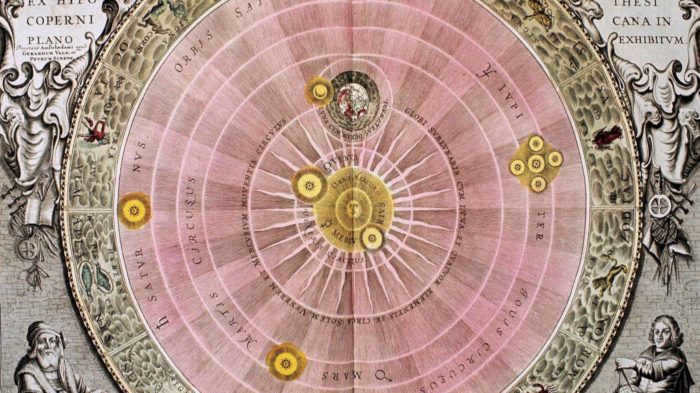
A representation of the Copernican solar system
The theory proposing that the planets revolve around the Sun was presented by Nicolaus Copernicus. He constructed his own model of the solar system and documented it in his work “On the rotation of the celestial spheres”. The publication was released in 1543 in Nuremberg. Some time later, Kepler demonstrated that the planets’ orbits are not circular, but rather elliptical. In 1687, Newton discovered the law of universal gravitation, which provided an explanation for the interaction between the planets and the Sun.
At present, humanity possesses sufficient knowledge and technology to accurately forecast the trajectory of any planet. It is with this information that rockets and satellites are launched, with the intention of meeting a specific celestial body at a designated point in space and at a predetermined time.
An engaging video showcasing the wonders of the Solar System
If you discover any mistakes, kindly highlight the text fragment and press Ctrl+Enter.
Final examination in the field of astronomy.
Please be aware that, in accordance with Federal Law No. 273-FZ “On Education in the Russian Federation,” educational institutions are required to provide inclusive education for students with disabilities, either in integrated classrooms or in separate classes or groups.
Tips and exercises for teachers to foster the development of a child’s cognitive functions.
Each participant will receive a certificate and discount.
1- Astronomy is a scientific discipline that investigates the movement and origin of celestial bodies and their systems.
A) the motion and origin of celestial bodies and their systems.
B) the study of celestial bodies and their characteristics.
B) the study of the motion, nature, origin, and development of celestial bodies and their systems.
2. A telescope is necessary in order to….
A) collect light and create an image of the object.
B) collect light from a celestial object and increase the field of view in which the object is observed.
C) obtain an enlarged image of a celestial body.
3. The highest point on the celestial sphere is known as the….
4. The line where the plane of the celestial horizon intersects with the meridian is referred to as the….
5. The angle between the planes of the great circles, one of which passes through the celestial poles and a specific celestial body, and the other through the celestial poles and the point of the vernal equinox, is called….
6. What is the Sun’s declination during the equinoxes?
7. Which planet is the third one from the Sun?
8. In what type of orbits do the planets revolve around the Sun?
B) in orbits that are close to circles.
9. The point in a planet’s orbit closest to the Sun is called the ….
10. As the observer moves away from the source of light, the spectrum lines ….
A) shift towards the purple end.
B) shift towards the red end.
11. All giant planets are characterized by ….
12. Asteroids orbit between the paths of ….
13. What elements dominate the atmospheres of stars?
14. Which class of stars does the Sun belong to?
15. How many constellations divide the sky?
16. Who discovered the laws of planetary motion around the Sun?
17. Which layer of the Sun serves as the primary source of visible radiation?
18. Convert 9 h 15 m 11 s into degrees.
19. The parallax of Altair is 0.20. What is the star’s distance in light-years?
20. How many times fainter is a star with a stellar magnitude of 3.4 compared to Sirius, which has an apparent stellar magnitude of 1.6?
Infoworks is seeking educators to join their team.
Online courses for teachers
Discover a wide range of resources for your lessons based on the subject (category), grade level, textbook, and topic:
Over 5,537,656 materials available in our database
Explore the significance of establishing reconciliation and mediation services in educational institutions.
Get a special discount on certificates and training for every participant.
More Resources
Check out these courses:
Drop a Comment
Sign in to post questions.
About the Author
- Website Presence: 6 years and 7 months
- Subscribers: 3
- Total Views: 91988
- Total Content: 43
Moscow Institute of Professional
Retraining and Continuing Education
Teacher Training
Online Courses for Educators
We provide official certification documents!
Insider Tips from Teachers on Successful Exam Preparation
There are currently no plans to fully transition schools to online learning
Students in St. Petersburg in grades 7 to 11 have been moved to online learning
The State Duma proposes to offer additional compensation to teachers working with students diagnosed with covid
In Russia, schools will transition to online learning if 20% of students become ill
Students in grades 5 to 11 in Voronezh will switch to online learning starting from February 3
Secondary school classes in Vladivostok are being moved to online learning
Gift certificates
The responsibility for resolving any disputes regarding the materials themselves and their content lies with the users who have posted the materials on the website. However, the website administration is prepared to offer full support in resolving any issues related to the website’s operations and content. If you come across any illegally used materials on this website, please inform the website administration through the provided feedback form.
All materials published on the website are either created by the website’s authors or contributed by its users, and are presented solely for informational purposes. The copyrights for these materials belong to their respective legal authors. Any partial or complete copying of the website’s materials without the written permission of the website administration is strictly prohibited! The administration’s views may not necessarily align with those of the authors.

Experienced stargazers have a deep understanding that the speed at which planets orbit is directly correlated with their proximity to the central celestial body – the Sun. As for those who are new to the fascinating field of astral objects, delving into this topic would likely prove to be quite intriguing.
What does orbital velocity mean?
Orbital velocity refers to the speed at which a planet moves along its orbit around the Sun. Contrary to popular belief, an orbit is not a perfect circle, nor is it entirely oval in shape. This is because there are numerous factors, beyond the Sun’s gravitational force, that can influence the motion of celestial objects.
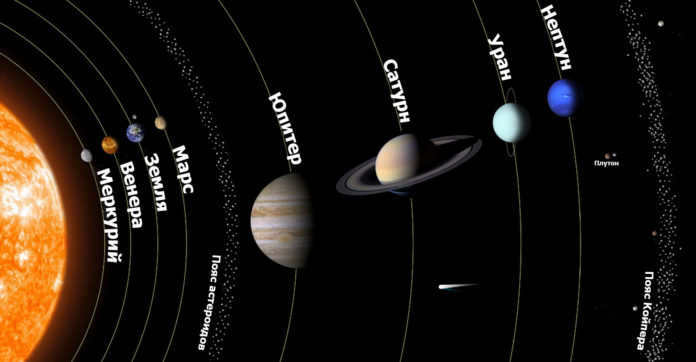
It is important to clarify that the Sun does not always occupy the exact center of the planetary orbits that revolve around it.
Furthermore, it is crucial to acknowledge that not all the planet orbits are aligned on the same plane. Some orbits deviate significantly – for instance, if we were to represent the standard orbits of Earth and Venus on an astronomical chart, we would observe only a few points of intersection between them.
Now that the arrangement of the orbits has been more or less organized, we can revisit the definition of orbital velocity for the planets. This is what astronomers refer to as the velocity at which a planet moves along its path. It may vary slightly – depending on the presence of nearby celestial bodies. This phenomenon is particularly noticeable in the case of Mars: whenever it comes close to Jupiter, its speed decreases slightly due to the gravitational pull from this massive planet.
Scientists have long established the correlation between the speed of the planets orbiting the Sun and their distance from it.
In other words, the planet closest to the Sun – Mercury – moves the fastest, while Pluto has the slowest velocity in the entire solar system.
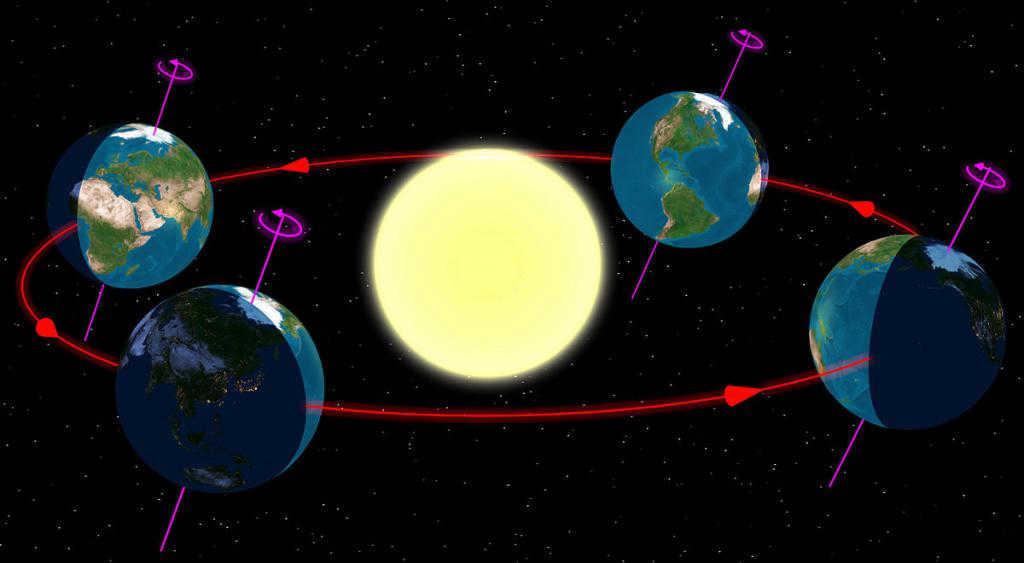
The reality is that each planet’s velocity corresponds to the gravitational force exerted on it by the Sun at a specific distance. If the velocity is too low, the planet will gradually approach the star and eventually be consumed by it. On the other hand, if the velocity is too high, the planet will simply drift away from the center of our solar system.
Every astronomer, even a novice, is well aware that the gravitational force weakens as one moves farther away from the Sun. This is why Mercury must travel at a breakneck speed to maintain its position in the solar system, while Mars can move at a slower pace, and Pluto hardly moves at all.
Mercury
Mercury is the planet closest to the Sun. This is the planet we will begin studying in order to understand the speeds of the other planets in our solar system.
Mercury not only has the smallest orbit, but it is also the smallest planet in our system. It is located less than 58 million kilometers from the Sun, which means that temperatures at its equator can reach 400 degrees Celsius or even higher on a hot day.
Moreover, in order to maintain its position in orbit so close to the Sun, the planet must travel at an astonishing velocity – approximately 47 kilometers per second. Due to its small radius, the length of Mercury’s orbit is relatively short, allowing it to complete a full revolution around the star in just 88 days. This means that New Year’s Eve occurs far more frequently on Mercury compared to Earth. However, the planet’s rotational speed around its axis is incredibly slow, with a complete revolution taking nearly 59 Earth days. As a result, a single day on Mercury is not significantly shorter than a full year.
Venus
Venus is the next planet in our solar system. It is the only planet where the Sun rises in the west and sets in the east. The distance from Venus to the center of the solar system is approximately 108 million kilometers. Due to this distance, Venus has a slower orbital speed compared to Mercury, with only 35 kilometers per second. Additionally, Venus has a unique orbit that is nearly a perfect circle, with an extremely small eccentricity.
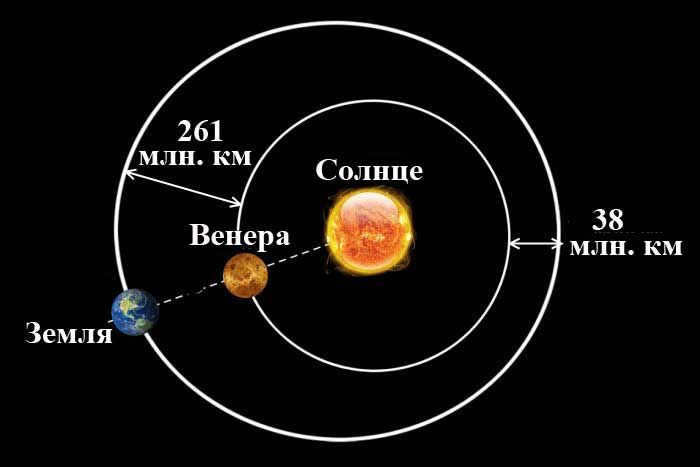
However, Venus has a significantly longer orbit compared to Mercury, which means that it takes Venus only 225 days to complete one full revolution around the sun. Interestingly, Venus also has a unique characteristic that sets it apart from all other planets in our solar system: its rotational period, or one day, is actually equivalent to 243 Earth days. As a result, a year on Venus is shorter than a day!
Our Planet Earth
Let’s take a moment to explore our remarkable home, planet Earth. With an average distance of nearly 150 million kilometers from the Sun, this measurement is commonly known as one astronomical unit. Astronomical units are used to calculate relatively small distances in the vastness of space.
It is truly astonishing to think that as you read this article, you are actually hurtling through space at a staggering speed of almost 30 kilometers per second, all while being safely cradled by the Earth. However, despite this incredible velocity, it takes our planet over 365 days, or one year, to complete a full orbit around the Sun. On the other hand, Earth spins on its axis quite briskly, completing a rotation in just 24 hours. Nevertheless, these fascinating details about our planet are well-known to most, so we won’t delve into them further. Instead, let’s move on to the next celestial body.
Mars
This celestial body is named after the formidable deity of conflict. As per all measurements, Mars is positioned in close proximity to Earth. For instance, its orbital velocity is 24 kilometers per second. The distance to the Sun is approximately 228 million kilometers, which results in the surface being predominantly chilly – during daylight hours it warms up to -5 degrees Celsius, while at night the temperature drops to -87 degrees.
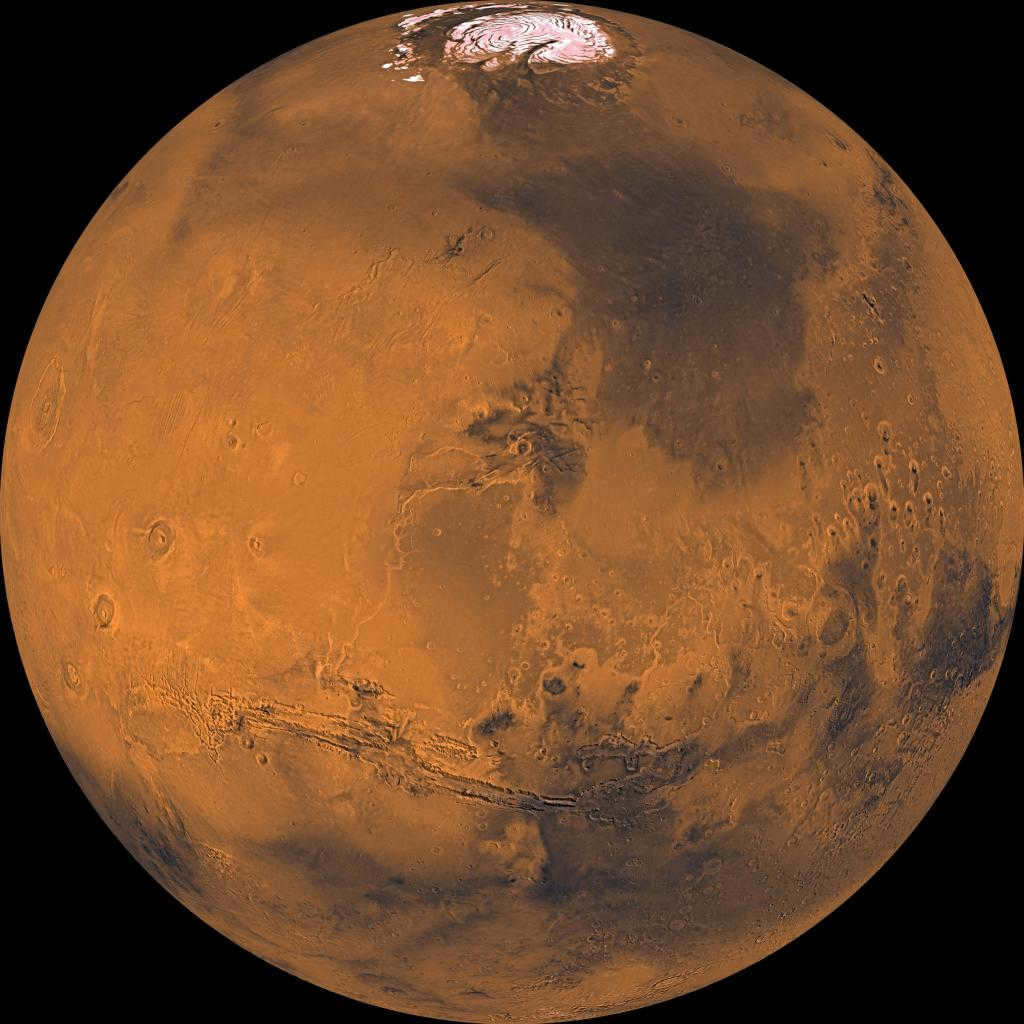
However, on Mars, a day is almost the same as on Earth, lasting 24 hours and 40 minutes. To simplify things, a new term has even been created for the Martian day – sol.
Due to the large distance from the Sun and the longer trajectory of its orbit compared to Earth, a year on Mars lasts a considerably longer time – a total of 687 days.
The planet’s eccentricity is not too significant, measuring about 0.09. This means that its orbit can be considered approximately circular, with the Sun positioned near the center of the circumscribed circle.
Jupiter
Jupiter was named after the mighty ancient Roman god, making it a fitting choice for the largest planet in our solar system. With a radius of nearly 70,000 square kilometers, Jupiter dwarfs Earth, which has a radius of just 6,371 kilometers.
Due to its distance from the Sun, Jupiter rotates at a relatively slow speed of only 13 kilometers per second. As a result, it takes this planet nearly 12 Earth years to complete a full orbit!
Despite its leisurely rotation around the Sun, Jupiter has the shortest day of any planet in our system, lasting only 9 hours and 50 minutes. The planet’s axis of rotation has a minuscule tilt of just 3 degrees, in stark contrast to Earth’s tilt of 23 degrees. This lack of tilt means that Jupiter experiences no seasons, and its temperature remains constant, only fluctuating slightly during its short days.
Jupiter has a relatively small eccentricity, measuring less than 0.05, which means it orbits the Sun in a circular and consistent manner.
Saturn
When it comes to size, Saturn is not far behind Jupiter and is actually the second largest celestial body in our solar system, with a radius of 58,000 kilometers.
Similar to Jupiter, Saturn’s orbital speed is also decreasing. In fact, it only travels at a speed of 9.7 kilometers per second. Despite this slow pace, Saturn covers a considerable distance, with its average distance from the Sun being nearly 9.6 astronomical units. It takes approximately 29.5 years for Saturn to complete one orbit around the Sun. However, Saturn has one of the shortest days in the entire solar system, lasting only 10.5 hours.
The eccentricity of the planet is nearly identical to that of Jupiter, with a value of 0.056. As a result, the planet’s orbit is relatively flat, and the difference between its perihelion and aphelion is only 162 million kilometers. Considering the immense distance to the Sun, this variation is relatively minor.
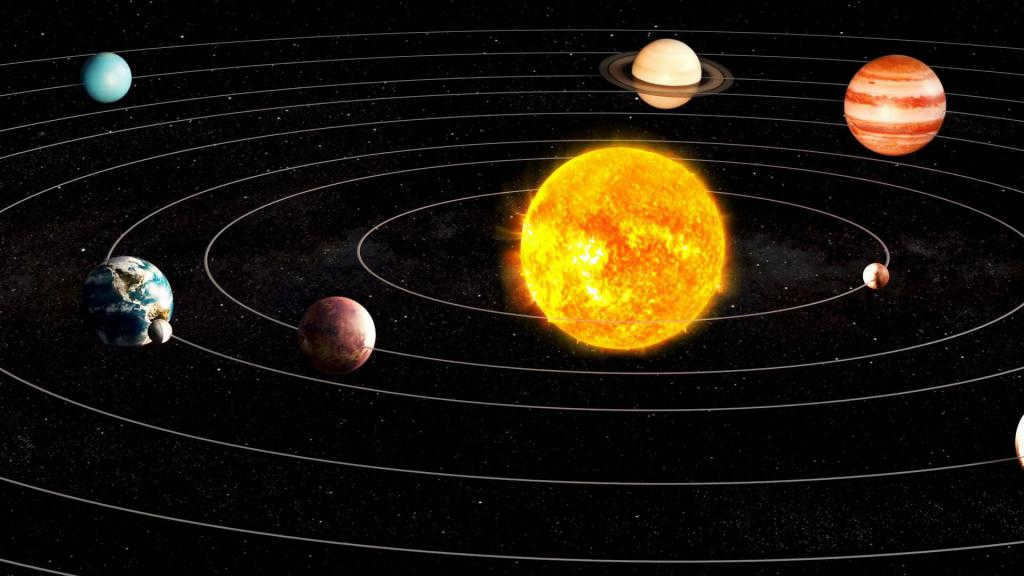
It is interesting to note that the planet Saturn also has rings that orbit around it. The outer layers of these rings move at a much slower speed compared to the inner layers.
Uranus
Uranus is another giant planet in the solar system. It is smaller in size compared to Jupiter and Saturn, but it is heavier than Neptune due to its dense core. The average distance between Uranus and the Sun is incredibly large, about 19 astronomical units. This great distance allows Uranus to move at a relatively slow pace, with its orbital speed not exceeding 7 kilometers per second. It takes Uranus a staggering 84 Earth years to complete one orbit around the Sun! That is an incredibly long period of time.
However, Uranus exhibits an astonishingly rapid rotation around its axis, completing a full revolution in a mere 18 hours!
One remarkable characteristic of this planet is its unique horizontal rotation, unlike any other planet in our solar system. Rather than spinning vertically on its axis, Uranus seemingly “rolls” along its orbit, as if lying on its side. Scientists attribute this peculiar behavior to a colossal cosmic collision during the planet’s formation, causing it to tilt. As a result, while the typical day on Uranus is incredibly brief, lasting just a few hours, the poles experience a day that extends for a staggering 42 years, followed by an equal duration of darkness.
Neptune
The planet Neptune was named after the ancient Roman god of the seas and oceans. It is no wonder that the symbol of the planet is a trident, which was also associated with Neptune. In terms of size, Neptune is the fourth largest planet in our solar system, coming in just slightly smaller than Uranus. Its average radius measures 24,600 kilometers, while Uranus has an average radius of 25,400 kilometers.
Neptune is located at an average distance of 4.5 billion kilometers, or 30 astronomical units, from the Sun. This means that the distance Neptune travels in its orbit is incredibly vast. Despite its distance from the Sun, Neptune has a relatively slow circular velocity of only 5.4 kilometers per second. As a result, one year on Neptune is equivalent to 165 Earth years.
Here’s an intriguing piece of information: the atmosphere in this place is quite thick (despite being composed primarily of methane), and occasionally, there are incredibly strong winds. These winds can reach speeds of up to 2100 kilometers per hour – on our planet, even a single gust of such magnitude would swiftly annihilate any city, leaving no building standing.
Pluto
Finally, the final celestial body on our compilation. More accurately, not even a celestial body, but a dwarf planet – it was recently excluded from the roster of planets due to its diminutive dimensions. Its average radius measures a mere 1187 kilometers – even our Moon exceeds this value with a figure of 1737 kilometers. Nevertheless, its appellation is quite formidable – it was bestowed in homage to the deity of the subterranean realm of the deceased in ancient Roman mythology.
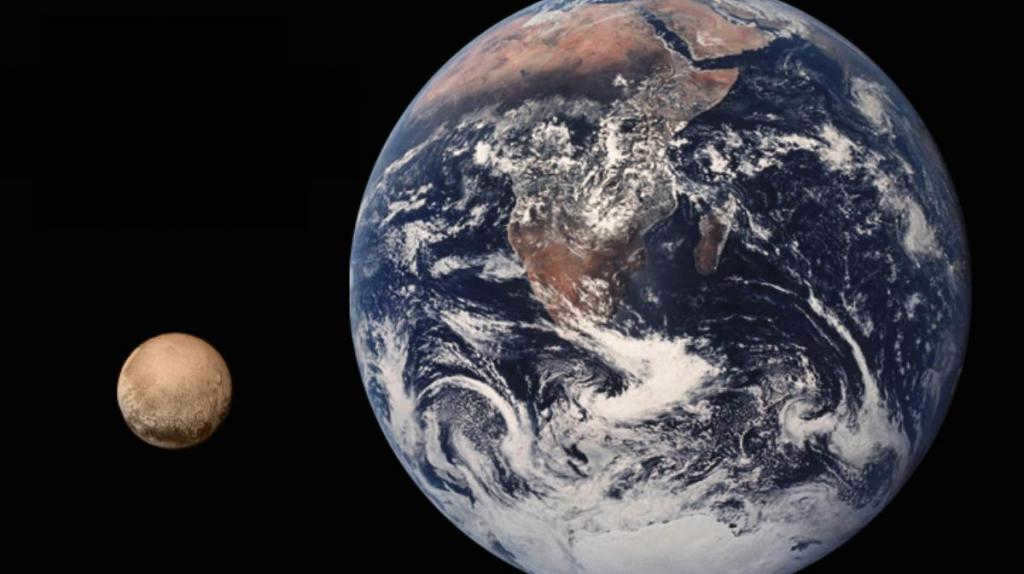
On average, Pluto is located at a distance of approximately 32 astronomical units from the Sun. This allows the dwarf planet to maintain a sense of security and move at a leisurely pace, with a speed of only 4.7 kilometers per second. Regardless of its slow speed, Pluto will not succumb to the intense heat of the Sun. However, due to its vast radius, it takes this miniscule planet a staggering 248 Earth years to complete a single orbit around the Sun.
In addition to its slow orbit, Pluto also rotates on its axis at a very leisurely pace. It takes approximately 152 Earth hours, which is equivalent to over 6 days, for Pluto to complete one full rotation.
